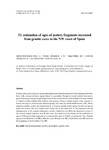TL estimation of ages of pottery fragments recovered from granite caves in the NW coast of Spain

View/
Use this link to cite
http://hdl.handle.net/2183/12589Collections
Metadata
Show full item recordTitle
TL estimation of ages of pottery fragments recovered from granite caves in the NW coast of SpainAuthor(s)
Date
2013Citation
Cadernos do laboratorio xeolóxico de Laxe, 2013, 37: 73-88. ISSN: 0213-4497
Abstract
[Abstract] Granite caves and cavities are geomorphological environments associated with underground water flows with a strong turbulent regime linked to seasonality. Though not much studied, they have a great sedimentary and geomorphological interest but sometimes also archaeological because remains of human activity (mainly lithic industry and pottery). Pottery remains appear either exposed or buried and may be characterised mineralogically and dated by thermoluminescence (TL). Water dynamics justifies erosion and fragmentation of ceramic remains which appear broken and spread inside the cavities. This fact hinders their dating due to the small size of the fragments and the disappearance of the original sedimentary context, which does not allow the calculation of part of the received annual radiation dose. In this work, the results from the dating and the estimation of ages of different ceramic fragments of several granite caves of Galicia are presented. The obtained ages go from Medieval (1 ka BP) to Roman or pre-Roman (2 ka BP), Chalcolithic (6 ka BP) and even the beginning of the Neolithic (7 ka BP).
Keywords
Thermoluminescence
Pottery
Pseudokarst
Granite caves
Pottery
Pseudokarst
Granite caves
ISSN
0213-4497





